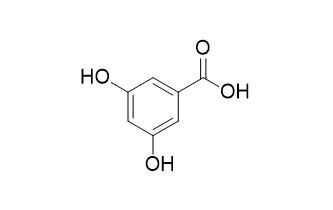3,5-Dihydroxybenzoic acid
3,5-Dihydroxybenzoic acid, a specific agonist for Hydroxycarboxylic Acid 1, inhibits lipolysis in adipocytes.
Inquire / Order:
manager@chemfaces.com
Technical Inquiries:
service@chemfaces.com
Tel:
+86-27-84237783
Fax:
+86-27-84254680
Address:
1 Building, No. 83, CheCheng Rd., Wuhan Economic and Technological Development Zone, Wuhan, Hubei 430056, PRC
Providing storage is as stated on the product vial and the vial is kept tightly sealed, the product can be stored for up to
24 months(2-8C).
Wherever possible, you should prepare and use solutions on the same day. However, if you need to make up stock solutions in advance, we recommend that you store the solution as aliquots in tightly sealed vials at -20C. Generally, these will be useable for up to two weeks. Before use, and prior to opening the vial we recommend that you allow your product to equilibrate to room temperature for at least 1 hour.
Need more advice on solubility, usage and handling? Please email to: service@chemfaces.com
The packaging of the product may have turned upside down during transportation, resulting in the natural compounds adhering to the neck or cap of the vial. take the vial out of its packaging and gently shake to let the compounds fall to the bottom of the vial. for liquid products, centrifuge at 200-500 RPM to gather the liquid at the bottom of the vial. try to avoid loss or contamination during handling.
Phytother Res.2022, 10.1002:ptr.7626.
Int J Mol Sci.2023, 24(6):5769.
J Ethnopharmacol.2019, 235:406-414
Separation Science Plus2022, sscp.202200048.
J Med Food.2021, 24(2):151-160.
Plant Archives2020, 2(1),2929-2934
Biomed Pharmacother.2023, 166:115329.
Int J Biol Macromol.2021, 199:189-200.
Antioxidants (Basel).2021, 10(1):112.
PLoS One.2022, 17(4):e0267007.
Related and Featured Products
Journal of Pharmacology & Experimental Therapeutics, 2012, 341(3):794-801.
3,5-Dihydroxybenzoic acid, a specific agonist for hydroxycarboxylic acid 1, inhibits lipolysis in adipocytes.[Reference:
WebLink]
Niacin raises high-density lipoprotein and lowers low-density lipoprotein through the activation of the β-hydroxybutyrate receptor hydroxycarboxylic acid 2 (HCA2) (aka GPR109a) but with an unwanted side effect of cutaneous flushing caused by vascular dilation because of the stimulation of HCA2 receptors in Langerhans cells in skin. HCA1 (aka GPR81), predominantly expressed in adipocytes, was recently identified as a receptor for lactate. Activation of HCA1 in adipocytes by lactate results in the inhibition of lipolysis, suggesting that agonists for HCA1 may be useful for the treatment of dyslipidemia. Lactate is a metabolite of glucose, suggesting that HCA1 may also be involved in the regulation of glucose metabolism. The low potency of lactate to activate HCA1, coupled with its fast turnover rate in vivo, render it an inadequate tool for studying the biological role of lactate/HCA1 in vivo.
METHODS AND RESULTS:
In this article, we demonstrate the identification of 3-hydroxybenzoic acid (3-HBA) as an agonist for both HCA2 and HCA1, whereas 3,5-Dihydroxybenzoic acid (3,5-DHBA) is a specific agonist for only HCA1 (EC(50) ∼150 μM). 3,5-DHBA inhibits lipolysis in wild-type mouse adipocytes but not in HCA1-deficient adipocytes.
CONCLUSIONS:
Therefore, 3,5-DHBA is a useful tool for the in vivo study of HCA1 function and offers a base for further HCA1 agonist design. Because 3-HBA and 3,5-DHBA are polyphenolic acids found in many natural products, such as fruits, berries, and coffee, it is intriguing to speculate that other heretofore undiscovered natural substances may have therapeutic benefits.



